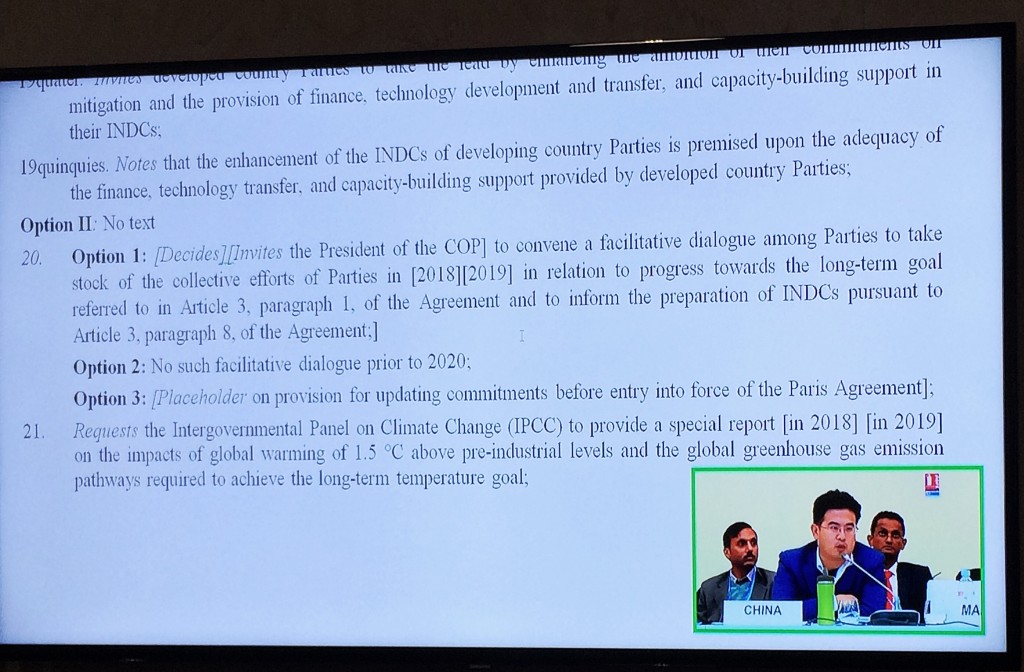
We’ve talked about “the negotiations” a lot, but what are the negotiators actually doing during those hours that they spend behind closed doors? They’re talking about language. I got a chance to see that first-hand (albeit at a slight remove) today. I was in a hallway in the building where most of the negotiations are taking place, and one of the video monitors in the hallway was showing a feed from one of the rooms. Mostly the video was of individual country delegates speaking, but briefly it showed the image above, display the section of the agreement text that presumably was the subject of current discussion.
At first glance, it looks pretty dull—most of us have edited texts before, and sometimes argued over wording details. But if you look closely at the paragraphs above (which are on page 28 of the new draft text released this morning), and think about how things differ if one option vs. the other is chosen, some of these things really make a difference in outcomes. Text in brackets indicates different possible wordings (per the U.N. editorial conventions), so if you look at Option 1, there’s a big difference between choosing “Decides” (it will really happen) vs. “Invites the President of the COP” (might or might not happen, depending on what the President does). And either of those is pretty different from Option 2, where it’s certain that nothing will happen before 2020.
And what’s happening (or possibly not happening) here is “stock-taking”, getting together to assess progress, and possibly increase effort, toward the goal of decreasing future warming. And what precisely is that goal (“referred to Article 3, paragraph 1”)? It is—you guessed it—still being negotiated, but it reads in part (after referring to yet a different article and paragraph):
“Hold the increase in the global average temperature [below 1.5 °C [or] [well] below 2 °C] above pre- industrial levels by ensuring deep cuts in global greenhouse gas [net] emissions;”
Clearly there is [work still to be done] [progress still to be made] [drama ahead]—stay tuned.
[Very] witty, Eric!
How long on average would you say it took the delegates to come to a decision on different phrases/wording of the document? Do you think they have done a good job of this so far?
-Sydney
Theses delegates are negotiating the language of a document, but once that document is done and agreed upon, what will it do? How will this document help to reduce climate change? Is it legally binding for the countries who are there and participating, or is it just a written agreement that may or may not be upheld once the conference is done?
This is really interesting. The actual way that a decision is made seems very interesting. Getting everyone on the same page about such a wide array of issues is a huge task. It seems like young people (and the general public) are having a bigger say in what they think on social media, how much of a difference do you think social media and other online opinions have made on shaping these agreements?
Regards,
Shannon
Do you feel as though the language barrier in the different languages spoken by the delegates also has an impact on the drafted texts and how long it takes them to decide?
-Lily and Lauren
Is there a specific way that you are able to keep arguments professional? We were also wondering, how long would you say the longest negotiation was? The shortest?
How can multiple countries come together to make one big decision or put forth an idea on how to solve this as a whole? Wouldn’t it be better for neighbouring countries or at least very close by countries to concur on a localized plan? In our opinions, splitting this argument up into parts to make up one whole would be extremely more effective than a long debate between a plethora of countries with varying opinions going in circles about how the plan could benefit them. If a whole bunch of countries are putting forth their opinions biased towards their own country, one unanimous, concise, plan cannot be reached.
Hey, Interesting idea for smaller groups to work on this issue too. How would you get countries to decide what to do? What part of a total world conference do you think is interesting for smaller countries to try to attend?